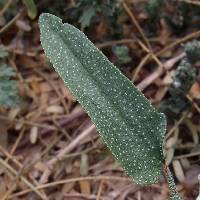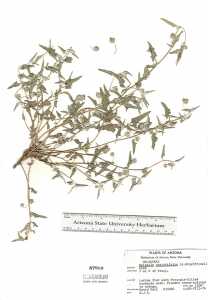|
|
 Leaves Sue Carnahan @http://swbiodiversity.org, Usage Rights: CC BY-NC (Attribution-Non-Commercial) |  Plant Arizona State University Vascular Plant Herbarium, Usage Rights: CC BY-NC (Attribution-Non-Commercial) | | | | |
|
Origin:
Native
Life Cycle:
Perennial Similar Species: Malvella leprosa
General Desc:
Low-growing plant with trailing, silvery, scaly stems that are clustered at the base. Green spearhead-shaped leaves are covered with silvery-white scale-like spots. Pale yellow cup-shaped flowers tinged pink grow singly between the leaves and the stem.
Identification notes: Perennial, stems clustered from base, trailing, silvery, covered with small scales (white dots); leaves much longer than broad, narrowly triangular, 2 to 4 spreading lobes at base, smooth margined; flowers solitary, pale yellow tinged pink, in leaf axils.
Height:
To 4 inches
Habitat Description: Often found in areas with heavy, saline soils and poor drainage, along roadsides, on mud or clay flats, along lake shores and on desert pans or playas (areas of flat, dried up land, especially a desert basin from which water evaporates quickly).
Plant Communities:
Desert Scrub, Interior Chaparral, Semidesert Grasslands, Riparian, Disturbed Areas
Elevation: 800 - 6000 feet
Color:
Pale yellow, tinged pink
Shape:
Regular not in clusters
Tubular:
N
Flowering Period:
Mar - Oct
Description:
Flowers have a cup-like shape with 5 overlapping petals each about 1/2 inch long. Flowers are a pale yellow (rarely white) and tinged pink especially with age. They grow singly from the leaf axils (between the leaf and the stem) rising above the foliage.
Leaf Color:
Green, silvery-white scales
Leaf Type:
Simple
Leaf Shape:
Triangular
Leaf Margin:
Smooth
Leaf Attachment:
Alternate
Leaves Clasp:
N
Hairs:
Leaves
Spines:
N
Leaf Description:
Leaves are narrowly triangular with 2 to 4 lobes at the base that extend outward, 1/2 to 1-1/2 inches long, leaves are 3 to 5 times as long as wide. Leaf surfaces are covered with silvery-white star-shaped hair-like scales (lepidote).
Fruit Notes: The fruit is called a shizocarp. It's dry, about 1/4 inch wide with a rounded shape that is flattened slightly at the top and bottom. It has 7 to 8 united parts (segments) that do not break apart when the fruit reaches maturity.
Seed Notes: Each individual segment of the fruit is called a "mericarp" and has a single hairless seed.
|
|